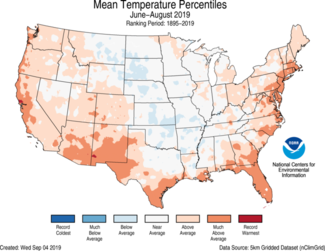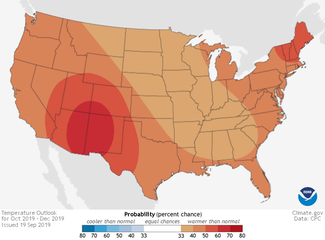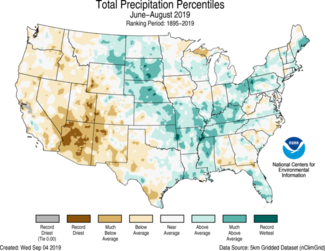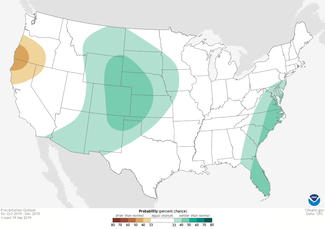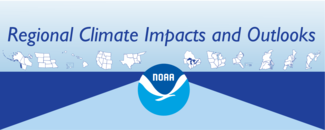
NOAA and its partners have released the latest Regional Climate Impacts and Outlooks, which recap summer conditions and provide insight into what to expect this fall.
Summer Temperature Recap
During meteorological summer (June–August), the average temperature for the Lower 48 was 72.4°F, 1.0°F above average, ranking in the upper third of the historical record.
Above- to much-above-average summer temperatures spanned from the West Coast to the Southwest and into the Deep South, as well as from the Gulf Coast to New England. Delaware, New Jersey, and Florida ranked fifth warmest, while New Mexico ranked sixth warmest. No state ranked below average for the summer season. The Alaska statewide average temperature for the summer was 54.6°F, 4.1°F above average and ranked as the second warmest such period on record.
Fall Temperature Outlook
According to NOAA’s Climate Prediction Center, the October–December 2019 temperature outlook favors above-normal temperatures, although probabilities vary. The highest regional probabilities for above-normal temperatures are forecast across parts of the Southwest, the Northeast, and the North Slope of Alaska. Probabilities for above-normal temperatures are lowest from the northern Great Plains and Upper Mississippi Valley to interior portions of the east-central Gulf Coast region and for interior parts of southern Alaska.
Summer Precipitation Recap
The summer precipitation total was 8.83 inches, 0.51 inch above average, ranking in the upper third of the historical record. Above- to much-above-average precipitation was observed from the northern Great Plains to the Gulf Coast and from the Ohio Valley into the Northeast. South Dakota had its fifth wettest June–August, while Kentucky experienced its sixth wettest such period on record.
Below- to much-below-average precipitation was observed across much of the West as well as in Iowa and upper Michigan. Arizona had its driest summer on record receiving about 40 percent of its seasonal average. California, New Mexico, and Utah had the tenth driest, or drier, summer.
Fall Precipitation Outlook
According to the Climate Prediction Center, the October–December 2019 precipitation outlook indicates that above-normal seasonal total precipitation is favored near the Atlantic Coast from Florida to New Jersey, much of the west-central and central CONUS, and Alaska (excluding the Panhandle). Below-normal precipitation is favored over the north-central portion of the West Coast.
Impacts and Outlooks for Your Region
Learn more details for your region in the September 2019 climate impacts and outlooks summaries:
- Alaska and Northwestern Canada Region
- Chesapeake Bay/Mid-Atlantic
- Great Lakes Region
- Gulf of Maine Region
- Midwest Region
- Missouri River Basin Region
- Northeast Region
- Pacific Region
- Southeast Region
- Southern Region
- Western Region
Creating These Quarterly Summaries
NOAA’s Regional Climate Services lead the production of these quarterly summaries of climate impacts and outlooks for various regions of the United States as well as parts of Canada along the border. This effort, which began in 2012, now includes as many as 11 unique regional products, all produced collaboratively with partner organizations.
You can access all of the Climate Impacts and Outlooks summaries as well as additional reports and assessments through the U.S. Drought Portal Reports web page at Drought.gov.

